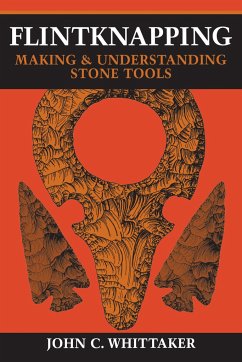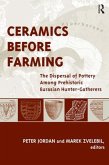- Broschiertes Buch
- Merkliste
- Auf die Merkliste
- Bewerten Bewerten
- Teilen
- Produkt teilen
- Produkterinnerung
- Produkterinnerung
Flintknapping, the making of stone tools, is an ancient craft enjoying a resurgence of interest among both amateur and professional students of prehistoric cultures. This guide contains detailed, practical information on making stone tools.
Andere Kunden interessierten sich auch für
![Violence and Warfare among Hunter-Gatherers Violence and Warfare among Hunter-Gatherers]() Violence and Warfare among Hunter-Gatherers58,99 €
Violence and Warfare among Hunter-Gatherers58,99 €![Ceramics Before Farming Ceramics Before Farming]() Ceramics Before Farming76,99 €
Ceramics Before Farming76,99 €![Foundations of Social Archaeology Foundations of Social Archaeology]() Foundations of Social Archaeology52,99 €
Foundations of Social Archaeology52,99 €![The Book of Chilam Balam of Chumayel The Book of Chilam Balam of Chumayel]() Ralph L RoysThe Book of Chilam Balam of Chumayel14,99 €
Ralph L RoysThe Book of Chilam Balam of Chumayel14,99 €![Mosaics in Roman Britain Mosaics in Roman Britain]() WittsMosaics in Roman Britain38,99 €
WittsMosaics in Roman Britain38,99 €![A Museum Studies Approach to Heritage A Museum Studies Approach to Heritage]() A Museum Studies Approach to Heritage70,99 €
A Museum Studies Approach to Heritage70,99 €![Zooarchaeology and Field Ecology Zooarchaeology and Field Ecology]() Jack M BroughtonZooarchaeology and Field Ecology42,99 €
Jack M BroughtonZooarchaeology and Field Ecology42,99 €-
-
-
Flintknapping, the making of stone tools, is an ancient craft enjoying a resurgence of interest among both amateur and professional students of prehistoric cultures. This guide contains detailed, practical information on making stone tools.
Hinweis: Dieser Artikel kann nur an eine deutsche Lieferadresse ausgeliefert werden.
Hinweis: Dieser Artikel kann nur an eine deutsche Lieferadresse ausgeliefert werden.
Produktdetails
- Produktdetails
- Verlag: UNIV OF TEXAS PR
- Seitenzahl: 352
- Erscheinungstermin: 1. Mai 1994
- Englisch
- Abmessung: 235mm x 155mm x 20mm
- Gewicht: 594g
- ISBN-13: 9780292790834
- ISBN-10: 029279083X
- Artikelnr.: 13677032
- Herstellerkennzeichnung
- Libri GmbH
- Europaallee 1
- 36244 Bad Hersfeld
- 06621 890
- Verlag: UNIV OF TEXAS PR
- Seitenzahl: 352
- Erscheinungstermin: 1. Mai 1994
- Englisch
- Abmessung: 235mm x 155mm x 20mm
- Gewicht: 594g
- ISBN-13: 9780292790834
- ISBN-10: 029279083X
- Artikelnr.: 13677032
- Herstellerkennzeichnung
- Libri GmbH
- Europaallee 1
- 36244 Bad Hersfeld
- 06621 890
John C. Whittaker is a professor of anthropology at Grinnell College and the author of American Flintknappers: Stone Age Art in the Age of Computers .
1. Acknowledgments
2. 1. Introduction
* Using This Book
* Learning to Knap
3. 2. Flintknapping: Basic Principles
* Flintknapping
* Conchoidal Fracture
* Properties of Material
* Flakes and Cores
4. 3. A Brief History of Flintknapping
* Prehistory of Stone Tools
* Recent "Stone-Age" People
* Modern Knapping
* Further Readings
* Other Resources: Finding Other Knappers
5. 4. Raw Materials
* Stone Quality
* Stone Materials
* Heat-Treating
* Collecting Material: Ethical and Practical Considerations
6. 5. Safety
* Proper Technique
* Eyes
* Hands
* Other Body Parts
* Lungs
* Waste Disposal
* Benefits
7. 6. Hard-Hammer Percussion
* Material and Equipment
* Percussion-Flaking Principles: An Experiment
* Percussion Flaking
* Platforms
* The Face of the Core
* Terminations
* Curvature
* Starting a Core
* Summary: Nine Essentials
* Examples
8. 7. Pressure Flaking
* Tools
* Raw Material
* First Principles
* Working Position
* Beginning
* Platform Preparation
* Thinning
* Notching
* Other Pressure-Flaking Techniques
* Summary: Six Essentials
* Application: Small Triangular Points from the Southwest
* Pressure-Flaking Problems
* Patterned Pressure Flaking
9. 8. Soft-Hammer Percussion and Bifaces
* Definitions
* Tools
* Beginning
* Soft-Hammer Principles and Results
* Biface Thinning Flakes
* Fracture Theories
* The Blow Platforms
* Biface Stages
* Knapping Strategy and Other Considerations
* Example: A Basic Biface
* Biface Problems: Prehistoric Mistakes
* Summary
10. 9. Blades and Fluting
* Blades
* Platforms
* Holding
* Punches
* The Blow
* Fluting
* Example: Fluted Point
11. 10. Using Stone Tools
* Stone vs. Steel
* Edges and Cutting
* Making a Projectile Foreshaft
* Going On
12. 11. Archaeological Analysis of Stone Tools
* Typology
* Stone Tool Types and Change through Time
* What People Did with Stones
* Sources of Variation: Why Stone Tools Are Not All Alike
* Analyzing Stone Tool Materials
* Technology and What It Tells Us
* Figuring Out Function
* Questions of Style
* Conclusions
13. Appendix: Resources for Knappers
14. References
15. Index
2. 1. Introduction
* Using This Book
* Learning to Knap
3. 2. Flintknapping: Basic Principles
* Flintknapping
* Conchoidal Fracture
* Properties of Material
* Flakes and Cores
4. 3. A Brief History of Flintknapping
* Prehistory of Stone Tools
* Recent "Stone-Age" People
* Modern Knapping
* Further Readings
* Other Resources: Finding Other Knappers
5. 4. Raw Materials
* Stone Quality
* Stone Materials
* Heat-Treating
* Collecting Material: Ethical and Practical Considerations
6. 5. Safety
* Proper Technique
* Eyes
* Hands
* Other Body Parts
* Lungs
* Waste Disposal
* Benefits
7. 6. Hard-Hammer Percussion
* Material and Equipment
* Percussion-Flaking Principles: An Experiment
* Percussion Flaking
* Platforms
* The Face of the Core
* Terminations
* Curvature
* Starting a Core
* Summary: Nine Essentials
* Examples
8. 7. Pressure Flaking
* Tools
* Raw Material
* First Principles
* Working Position
* Beginning
* Platform Preparation
* Thinning
* Notching
* Other Pressure-Flaking Techniques
* Summary: Six Essentials
* Application: Small Triangular Points from the Southwest
* Pressure-Flaking Problems
* Patterned Pressure Flaking
9. 8. Soft-Hammer Percussion and Bifaces
* Definitions
* Tools
* Beginning
* Soft-Hammer Principles and Results
* Biface Thinning Flakes
* Fracture Theories
* The Blow Platforms
* Biface Stages
* Knapping Strategy and Other Considerations
* Example: A Basic Biface
* Biface Problems: Prehistoric Mistakes
* Summary
10. 9. Blades and Fluting
* Blades
* Platforms
* Holding
* Punches
* The Blow
* Fluting
* Example: Fluted Point
11. 10. Using Stone Tools
* Stone vs. Steel
* Edges and Cutting
* Making a Projectile Foreshaft
* Going On
12. 11. Archaeological Analysis of Stone Tools
* Typology
* Stone Tool Types and Change through Time
* What People Did with Stones
* Sources of Variation: Why Stone Tools Are Not All Alike
* Analyzing Stone Tool Materials
* Technology and What It Tells Us
* Figuring Out Function
* Questions of Style
* Conclusions
13. Appendix: Resources for Knappers
14. References
15. Index
1. Acknowledgments
2. 1. Introduction
* Using This Book
* Learning to Knap
3. 2. Flintknapping: Basic Principles
* Flintknapping
* Conchoidal Fracture
* Properties of Material
* Flakes and Cores
4. 3. A Brief History of Flintknapping
* Prehistory of Stone Tools
* Recent "Stone-Age" People
* Modern Knapping
* Further Readings
* Other Resources: Finding Other Knappers
5. 4. Raw Materials
* Stone Quality
* Stone Materials
* Heat-Treating
* Collecting Material: Ethical and Practical Considerations
6. 5. Safety
* Proper Technique
* Eyes
* Hands
* Other Body Parts
* Lungs
* Waste Disposal
* Benefits
7. 6. Hard-Hammer Percussion
* Material and Equipment
* Percussion-Flaking Principles: An Experiment
* Percussion Flaking
* Platforms
* The Face of the Core
* Terminations
* Curvature
* Starting a Core
* Summary: Nine Essentials
* Examples
8. 7. Pressure Flaking
* Tools
* Raw Material
* First Principles
* Working Position
* Beginning
* Platform Preparation
* Thinning
* Notching
* Other Pressure-Flaking Techniques
* Summary: Six Essentials
* Application: Small Triangular Points from the Southwest
* Pressure-Flaking Problems
* Patterned Pressure Flaking
9. 8. Soft-Hammer Percussion and Bifaces
* Definitions
* Tools
* Beginning
* Soft-Hammer Principles and Results
* Biface Thinning Flakes
* Fracture Theories
* The Blow Platforms
* Biface Stages
* Knapping Strategy and Other Considerations
* Example: A Basic Biface
* Biface Problems: Prehistoric Mistakes
* Summary
10. 9. Blades and Fluting
* Blades
* Platforms
* Holding
* Punches
* The Blow
* Fluting
* Example: Fluted Point
11. 10. Using Stone Tools
* Stone vs. Steel
* Edges and Cutting
* Making a Projectile Foreshaft
* Going On
12. 11. Archaeological Analysis of Stone Tools
* Typology
* Stone Tool Types and Change through Time
* What People Did with Stones
* Sources of Variation: Why Stone Tools Are Not All Alike
* Analyzing Stone Tool Materials
* Technology and What It Tells Us
* Figuring Out Function
* Questions of Style
* Conclusions
13. Appendix: Resources for Knappers
14. References
15. Index
2. 1. Introduction
* Using This Book
* Learning to Knap
3. 2. Flintknapping: Basic Principles
* Flintknapping
* Conchoidal Fracture
* Properties of Material
* Flakes and Cores
4. 3. A Brief History of Flintknapping
* Prehistory of Stone Tools
* Recent "Stone-Age" People
* Modern Knapping
* Further Readings
* Other Resources: Finding Other Knappers
5. 4. Raw Materials
* Stone Quality
* Stone Materials
* Heat-Treating
* Collecting Material: Ethical and Practical Considerations
6. 5. Safety
* Proper Technique
* Eyes
* Hands
* Other Body Parts
* Lungs
* Waste Disposal
* Benefits
7. 6. Hard-Hammer Percussion
* Material and Equipment
* Percussion-Flaking Principles: An Experiment
* Percussion Flaking
* Platforms
* The Face of the Core
* Terminations
* Curvature
* Starting a Core
* Summary: Nine Essentials
* Examples
8. 7. Pressure Flaking
* Tools
* Raw Material
* First Principles
* Working Position
* Beginning
* Platform Preparation
* Thinning
* Notching
* Other Pressure-Flaking Techniques
* Summary: Six Essentials
* Application: Small Triangular Points from the Southwest
* Pressure-Flaking Problems
* Patterned Pressure Flaking
9. 8. Soft-Hammer Percussion and Bifaces
* Definitions
* Tools
* Beginning
* Soft-Hammer Principles and Results
* Biface Thinning Flakes
* Fracture Theories
* The Blow Platforms
* Biface Stages
* Knapping Strategy and Other Considerations
* Example: A Basic Biface
* Biface Problems: Prehistoric Mistakes
* Summary
10. 9. Blades and Fluting
* Blades
* Platforms
* Holding
* Punches
* The Blow
* Fluting
* Example: Fluted Point
11. 10. Using Stone Tools
* Stone vs. Steel
* Edges and Cutting
* Making a Projectile Foreshaft
* Going On
12. 11. Archaeological Analysis of Stone Tools
* Typology
* Stone Tool Types and Change through Time
* What People Did with Stones
* Sources of Variation: Why Stone Tools Are Not All Alike
* Analyzing Stone Tool Materials
* Technology and What It Tells Us
* Figuring Out Function
* Questions of Style
* Conclusions
13. Appendix: Resources for Knappers
14. References
15. Index








